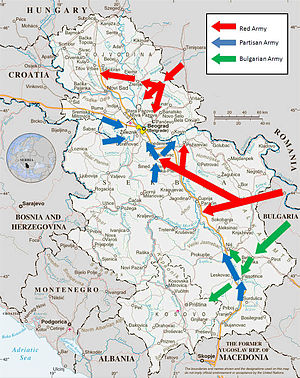This article may be a rough translation from Serbo-Croatian. It may have been generated, in whole or in part, by a computer or by a translator without dual proficiency. (March 2024) |
| Battle of Serbia | |||||||
|---|---|---|---|---|---|---|---|
| Part of World War II in Yugoslavia | |||||||
 Belgrade offensive | |||||||
| |||||||
| Belligerents | |||||||
|
|
| ||||||
| Commanders and leaders | |||||||
|
|
| ||||||
The Battle of Serbia was a joint Allied effort with the aim of establishing a strong foothold and mastering the central communication area of the German forces on the Balkans, i.e. Army Group F, during World War II. Actions on the ground were carried out by the NOVJ, and the Allies provided combat assistance, supplies and air support.
The territory of Serbia was, however, of key importance for all actors. All four specific actors: the German Southeast Command, Allied Mediterranean Command, NOVJ and JVuO, they had specific interests in Serbia, and based on them they formulated their strategies. Coalitions were formed based on matching interests.
From the end of 1943. The Allies changed their attitude towards Mihailović's forces, and the priority of their policy in Yugoslavia became helping to strengthen the NOVJ forces in Serbia [1] The Supreme Headquarters of the NOVJ made plans to support the strengthening of partisan forces in Serbia by the penetration of stronger forces from Bosnia and Montenegro. The German command, as well as Mihailović, were determined to prevent it.
Considering the Drina as a natural obstacle suitable for defense, the NOVJ plans consisted in concentrating forces on the left side of the Lim, where units collected and prepared for penetration deep into Serbia. Germany Southeast Command with this in mind decided to defend Serbia with active actions - by preventing the movement of units of the NOVJ through Bosnia across the west, as well as a series of large and ambitious operations in Sandžak and eastern Bosnia calculated to break the NOVJ concentrations and disable them for offensive operations. The forces of the JVuO, for their part, participated with great enthusiasm in these operations, as well as in those organized by the German commander of Serbia against local partisans.
The peak of this collaboration occurred in August 1944,[2][3] which was also a turning point in which the most intense and massive actions took place. The efforts of the NOVJ ended in success after long, exhausting battles. During the first days of August, a group of NOVJ divisions (2,5) managed to break through from Montenegro Gore and forces Ibar. On August 21, the First Proletarian Division penetrated into western Serbia, soon followed by the Sixth Lička, and in early September the Twelfth Corps. These forces liberated many towns (Gornji Milanovac on September 12, Valjevo on September 18, Arandjelovac on September 20) and established a base for the upcoming attack on Belgrade. In the first half of September, the German defense of Serbia from the west, already compromised by major penetrations of the NOVJ, experienced a breakdown due to the outbreak of the Red Army threat from the east.
At that moment, Allies and NOVJ had a decisive advantage. Operation Ratweek and the fighting in Macedonia prevented the Germans from trying to effectively reinforce the defenses of Serbia, and the battle for Serbia was definitely decided during October, Belgrade operation - the invasion of the well-equipped forces of the Red Army, to which the NOVJ represented a valuable partner, both by covering the territory and communications in depth, as well and as frontline infantry.
The battle for Serbia was thus resolved. Further fighting in the southwestern part was not aimed at regaining control over Serbia, but the breakthrough of German Army Group E from Greece.
During the Battle of Serbia 1944, the partisans, with the support of the allies, led the fight for liberation from the occupiers and the coming to power, while the Chetnik units, left without the support of the allies, entered into full collaboration at all levels in an attempt to prevent the arrival communist competitors for power.[4]
- ^ /00001/1_11.htm Fitzroy McClain: THE WAR IN THE BALKANS, Chapter 11 - THE NEW DEAL
- ^ [War diary of the command of Army Group "F" for the period from July 1 to December 31, 1944, https://www.znaci.org/00001/ 4_12_4_218.htm] Collection of documents and data about the NOR, volume XII (German documents), book 4, Institute of Military History, Belgrade - attachment 1
- ^ [Official note of an officer of the Abwehr Command of the Southeast from August 22, 1944. from the briefing of the commander of the Southeast to Adolf Hitler, https://www.znaci.org/00001/4_12_4_112.htm] Collection of documents and data about NOR, volume XII (German documents), book 4, Institute of Military History, Belgrade - document 112
- ^ Dubravka Stojanović: Oil on water
© MMXXIII Rich X Search. We shall prevail. All rights reserved. Rich X Search
